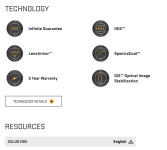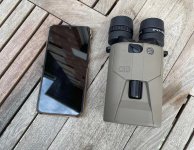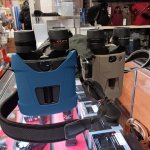-
Welcome to BirdForum, the internet's largest birding community with thousands of members from all over the world. The forums are dedicated to wild birds, birding, binoculars and equipment and all that goes with it.
Please register for an account to take part in the discussions in the forum, post your pictures in the gallery and more.
You are using an out of date browser. It may not display this or other websites correctly.
You should upgrade or use an alternative browser.
You should upgrade or use an alternative browser.
16x and steady views. Sig Zulu6 16x42 (2 Viewers)
- Thread starter rdnzl
- Start date
More options
Who Replied?Elpha8888
Well-known member

Thanks, I'm considering the Sigg after Dennis and others glowing reports but your findings are very interesting, I'll definitely need to check these out before purchase. I hope Dennis can chime in again and give his thoughts on this, I've had two Canon 15x and the last one was sent back, was quite disappointed with the view, possible alignment issues and stars were not very pleasing, that may have something to do with using Swarovski for the past few years on the night sky and possibly being spoilt with that wonderful glass, either way my eyes felt funny with the Canon.A local store has the non-HDX 16x42 and new HDX 16x42. I took my Canon 15x50 to compare outdoors, but I was really there to see the new 56mm scope from Vortex!
Most of my time and attention was on the scope but I did take some notes.
Conditions were hot and sunny. Lot of heat haze but I was able to look up into some trees and elevated objects.
I didn't notice such a big difference in terms of color or cast like I did with the non-HDX. If I recall correctly, it was more overcast that day though. Maybe that makes a difference.
I could see more detail at several hundred yards with the HDX than my Canon, in the center portion. That was looking at a shaded section of a fir tree. Better resolution or the extra 1x? Or maybe just better contrast, as the bark seemed more uniformly colored with the Canon whereas the SIG showed different shades.
The view was definitely more pleasing with the Canon. More relaxed and sharp to the edges. The HDX definitely was not sharp to the edges just like the non-HDX.
I didn't notice any difference in terms of brightness like I did with the non-HDX, but it was really sunny.
Unlike the non-HDX, I didn't notice any color fringing with the HDX but didn't go out of my way to look for it either. The non-HDX has very noticeable fringing to me.
The HDX still had blue around the periphery, but I think it has to do with the eye relief not working with my glasses. When I owned the non-HDX I was wearing contact lenses and never noticed the blue edge.
I don't know why I would see blue around the edges with the HDX and non-HDX but with both the blue gets noticeably brighter whenever the binoculars are pointed towards a brighter part of the viewing area. Could it be light from the edges of a lens?
I aggressively trimmed the rubber cups on my Canon and get full FOV. It's actually much easier to use than the SIG as crazy as that may seem.
The HDX seems like an improvement. And I still like the weight and size of the SIG over the Canon. The overall view of the Canon is still better to me especially with glasses.
I keep thinking about Roger Vine's review of the Canon. It has a nice flat image that is sharp nearly to the edge but it's not a beautiful image to me. Hard to describe but I can relate to his review. Very utilitarian I guess you could call it but when I examine the entire FOV, it's all sharp.
The HDX strikes me as being very functional. I can see what I need to, but when I examine the FOV it drops off away from center.
I was hoping that the HDX would blow me away right away. It didn't, but is an improvement over the non-HDX.
I may compare again on an overcast day.
Stabilised is the way for me these days and was hoping the Sigg could deliver. More research needed. Thanks
I may try comparing my 15x50 Canon to the 16x42 HDX again, but this time with both tripod mounted so I can quickly go back and forth. I don't expect my initial impressions to change much, but am curious if the HDX can actually resolve more in that center FOV region. Hopefully a different sample of the HDX too. There's another shop that might have one in stock.Thanks, I'm considering the Sigg after Dennis and others glowing reports but your findings are very interesting, I'll definitely need to check these out before purchase.
I compared my 15x Canon to the 15x SLC once, both tripod mounted. The SLC was definitely brighter with more contrast to my eyes. However, I was not able to see any additional detail over the Canon. This was indoors in a large convention center, which was maybe not ideal, but the acoustic panels had intricate detail so I used those as makeshift targets at varying distances. The SLC was definitely a more beautiful image to my eyes and brain though! Samples of one.
Hi,
Did anyone had a chance to compare both 16 and 20 in day and low light, in sunny or cloudy conditions?
Any big difference? Which one would you recommend for all around use and why?
I am leaning towards 20 for more zoom, but not sure about low light performance, and a smaller field of view.
Did anyone see any noticeable stabilization difference?
I had regular/non HDX 16x42 before and liked it, but the quality of the glass was so so in comparison with canon L10x42 and Fujinon TSX1440. Now with HDX glass I hear a lot of positive feedback.
Any other going with 20x42 vs 16x42 opinion/advice would is highly appreciated.
Thanks a lot!
Did anyone had a chance to compare both 16 and 20 in day and low light, in sunny or cloudy conditions?
Any big difference? Which one would you recommend for all around use and why?
I am leaning towards 20 for more zoom, but not sure about low light performance, and a smaller field of view.
Did anyone see any noticeable stabilization difference?
I had regular/non HDX 16x42 before and liked it, but the quality of the glass was so so in comparison with canon L10x42 and Fujinon TSX1440. Now with HDX glass I hear a lot of positive feedback.
Any other going with 20x42 vs 16x42 opinion/advice would is highly appreciated.
Thanks a lot!
I got Zulu 6 HDX 16x42 a week ago and here are my findings after using it for couple of days.
PROs:
PROs:
- low volume, slim profile, extremely lightweight for 16x (only 21.9oz or 621g), awesome futuristic design
- best-in-class Image Stabilization (3° Correction angle vs. 2° for Kite APC vs. 0.9° for Canon IS) without artifacts
- IS is totally silent (good for hunting, birding, surveillance), 1 AA battery lasts 30h vs 3-8h for Canon IS
- best glass in its price-class with ED & HT glass and no observed CA at 16x
- 61° AFOV, 2.65mm exit pupil, 4m close focus (I measured 3m) are sufficient for most applications
- totally waterproof IPX7, non-slippery surface, scratch resistant lens coatings, love FDE color
- infinite guarantee (repairs and replacements at no charge), 5 year warranty on electronic components vs. 3 years for Canon
- zero eye fatigue after prolonged use, beats all non-stabilized alpha bins in terms of resolution handheld vs. handheld
- perfect for hunting, travel, cruises, general nature, surveillance, bird watching, plane spotting, handheld astronomy, sport fishing, etc.
- can be easily used with one hand only
- no proper lens caps, carrying case could be of better quality, better fit & matching color
- new "Target Mode" is really rock-steady but image gets a little bit less sharp compared to "Scan Mode"
- metal rings on the neck strap may produce loud sound when hitting sides of binocular
Paultricounty
Well-known member

Very informative review. Why is it less sharp in target mode?I got Zulu 6 HDX 16x42 a week ago and here are my findings after using it for couple of days.
PROs:
CONs:
- low volume, slim profile, extremely lightweight for 16x (only 21.9oz or 621g), awesome futuristic design
- best-in-class Image Stabilization (3° Correction angle vs. 2° for Kite APC vs. 0.9° for Canon IS) without artifacts
- IS is totally silent (good for hunting, birding, surveillance), 1 AA battery lasts 30h vs 3-8h for Canon IS
- best glass in its price-class with ED & HT glass and no observed CA at 16x
- 61° AFOV, 2.65mm exit pupil, 4m close focus (I measured 3m) are sufficient for most applications
- totally waterproof IPX7, non-slippery surface, scratch resistant lens coatings, love FDE color
- infinite guarantee (repairs and replacements at no charge), 5 year warranty on electronic components vs. 3 years for Canon
- zero eye fatigue after prolonged use, beats all non-stabilized alpha bins in terms of resolution handheld vs. handheld
- perfect for hunting, travel, cruises, general nature, surveillance, bird watching, plane spotting, handheld astronomy, sport fishing, etc.
- can be easily used with one hand only
Show less
- no proper lens caps, carrying case could be of better quality, better fit & matching color
- new "Target Mode" is really rock-steady but image gets a little bit less sharp compared to "Scan Mode"
- metal rings on the neck strap may produce loud sound when hitting sides of binocular
Paul
I got Zulu 6 HDX 16x42 a week ago and here are my findings after using it for couple of days.
PROs:
CONs:
- low volume, slim profile, extremely lightweight for 16x (only 21.9oz or 621g), awesome futuristic design
- best-in-class Image Stabilization (3° Correction angle vs. 2° for Kite APC vs. 0.9° for Canon IS) without artifacts
- IS is totally silent (good for hunting, birding, surveillance), 1 AA battery lasts 30h vs 3-8h for Canon IS
- best glass in its price-class with ED & HT glass and no observed CA at 16x
- 61° AFOV, 2.65mm exit pupil, 4m close focus (I measured 3m) are sufficient for most applications
- totally waterproof IPX7, non-slippery surface, scratch resistant lens coatings, love FDE color
- infinite guarantee (repairs and replacements at no charge), 5 year warranty on electronic components vs. 3 years for Canon
- zero eye fatigue after prolonged use, beats all non-stabilized alpha bins in terms of resolution handheld vs. handheld
- perfect for hunting, travel, cruises, general nature, surveillance, bird watching, plane spotting, handheld astronomy, sport fishing, etc.
- can be easily used with one hand only
Show less
- no proper lens caps, carrying case could be of better quality, better fit & matching color
- new "Target Mode" is really rock-steady but image gets a little bit less sharp compared to "Scan Mode"
- metal rings on the neck strap may produce loud sound when hitting sides of binocular
I also just got one last week. I'm not sure whats going on, but I've noticed the sweet spot is slightly below the center of the view where it is expected to be. What I mean by this, is if I look at the very center of the view, it is less sharp than if I look a little below the center. Also looking up from the center of the view to the upper half of the image, it becomes blurry quicker than expected, more so than looking at the lower half of the image.
It's almost like the sweet spot is positioned lower in the image than it should be. Have you noticed this on yours?
It does seem to provide a very nice overall image... If I center the bird slightly below the center of the view.
Paultricounty
Well-known member

That’s interesting in itself, over $1000 and there’s no definitive central sweet spot ? I’m still curious why the image would be degraded based on which of the two IS settings one is using.I also just got one last week. I'm not sure whats going on, but I've noticed the sweet spot is slightly below the center of the view where it is expected to be. What I mean by this, is if I look at the very center of the view, it is less sharp than if I look a little below the center. Also looking up from the center of the view to the upper half of the image, it becomes blurry quicker than expected, more so than looking at the lower half of the image.
It's almost like the sweet spot is positioned lower in the image than it should be. Have you noticed this on yours?
It does seem to provide a very nice overall image... If I center the bird slightly below the center of the view.
Paul
Sorry to hear it Travis. I did not experience this problem with my bin. Center of the image is perfectly sharp. Positioning of eyes may play a role. I would recommend to exchange your bin and check whether it will fix the issue.I also just got one last week. I'm not sure whats going on, but I've noticed the sweet spot is slightly below the center of the view where it is expected to be. What I mean by this, is if I look at the very center of the view, it is less sharp than if I look a little below the center. Also looking up from the center of the view to the upper half of the image, it becomes blurry quicker than expected, more so than looking at the lower half of the image.
It's almost like the sweet spot is positioned lower in the image than it should be. Have you noticed this on yours?
It does seem to provide a very nice overall image... If I center the bird slightly below the center of the view.
Hi Paul. Good question. Difference is very minimal during regular use. But it may become noticeable when reading fine print from a distance or moon gazing. "Target mode" probably uses different stabilization mechanics. It can be activated only when "Scan mode" is turned ON. I need to test it a bit more with resolution charts, focus adjustments, etc. Despite very slight loss in sharpness, it significantly increases stability in situations when glassing from a moving vehicle or shaky boat.Very informative review. Why is it less sharp in target mode?
Paul
Last edited:
I would love to hear about the optical differences, if you found anyRecently I made a trip to a local bino store in order to compare Zulu 6 HDX with its made in Japan "cousin" Kite APC.
Volume and weight differences were more significant than expected.
As far as I understand, part of the reason for the wider body of the Kite is due to the fact that it actually has 2 separate battery compartments. On each side it carries two batteries (4 in total): 2 are in use and 2 are the spare set (to avoid running out of juice, thus "doubling" the on use time on the field. But, yes, looking at your picture there is quite a substantial difference indeed!
Paultricounty
Well-known member

But no problems carrying a Swaro SLC 56 🤔😵💫. Oh the hypocrisy.More like being in purgatory and being punished by having to carry the brick like Canon 10x42 IS-L around.
The website indicates that in addition to the "Infinite Guarantee" that the warranty is only 5 years. How do the two policies interact?And there is this:View attachment 1511132

Last edited:
Conndomat
United States of Europe

The 5 year guarantee is for the stabilizer.The website indicates that in addition to the "Infinite Guarantee" that the warranty is only 5 years. How do the two policies interact?
Andreas
Users who are viewing this thread
Total: 3 (members: 0, guests: 3)






